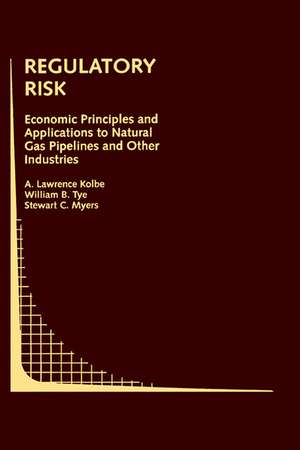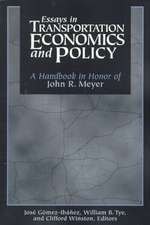Regulatory Risk: Economic Principles and Applications to Natural Gas Pipelines and Other Industries: Topics in Regulatory Economics and Policy, cartea 14
Autor A. Lawrence Kolbe, William B. Tye, Stewart C. Myersen Limba Engleză Hardback – 30 apr 1993
| Toate formatele și edițiile | Preț | Express |
|---|---|---|
| Paperback (1) | 947.67 lei 6-8 săpt. | |
| Springer Us – 30 sep 2012 | 947.67 lei 6-8 săpt. | |
| Hardback (1) | 954.45 lei 6-8 săpt. | |
| Springer Us – 30 apr 1993 | 954.45 lei 6-8 săpt. |
Din seria Topics in Regulatory Economics and Policy
- 18%
 Preț: 893.71 lei
Preț: 893.71 lei - 18%
 Preț: 1108.67 lei
Preț: 1108.67 lei - 18%
 Preț: 899.06 lei
Preț: 899.06 lei - 24%
 Preț: 747.51 lei
Preț: 747.51 lei - 18%
 Preț: 1118.75 lei
Preț: 1118.75 lei - 15%
 Preț: 649.87 lei
Preț: 649.87 lei - 18%
 Preț: 1117.03 lei
Preț: 1117.03 lei - 15%
 Preț: 593.08 lei
Preț: 593.08 lei - 18%
 Preț: 789.98 lei
Preț: 789.98 lei - 18%
 Preț: 1233.20 lei
Preț: 1233.20 lei - 18%
 Preț: 944.99 lei
Preț: 944.99 lei - 15%
 Preț: 640.71 lei
Preț: 640.71 lei - 18%
 Preț: 953.35 lei
Preț: 953.35 lei - 18%
 Preț: 953.35 lei
Preț: 953.35 lei -
 Preț: 385.47 lei
Preț: 385.47 lei - 15%
 Preț: 647.27 lei
Preț: 647.27 lei - 15%
 Preț: 639.90 lei
Preț: 639.90 lei - 15%
 Preț: 643.34 lei
Preț: 643.34 lei - 18%
 Preț: 951.14 lei
Preț: 951.14 lei - 18%
 Preț: 948.47 lei
Preț: 948.47 lei - 15%
 Preț: 646.11 lei
Preț: 646.11 lei - 18%
 Preț: 1487.96 lei
Preț: 1487.96 lei - 15%
 Preț: 640.71 lei
Preț: 640.71 lei - 18%
 Preț: 950.03 lei
Preț: 950.03 lei - 15%
 Preț: 643.34 lei
Preț: 643.34 lei - 15%
 Preț: 647.40 lei
Preț: 647.40 lei
Preț: 954.45 lei
Preț vechi: 1163.97 lei
-18% Nou
Puncte Express: 1432
Preț estimativ în valută:
182.65€ • 198.34$ • 153.43£
182.65€ • 198.34$ • 153.43£
Carte tipărită la comandă
Livrare economică 22 aprilie-06 mai
Preluare comenzi: 021 569.72.76
Specificații
ISBN-13: 9780792393306
ISBN-10: 0792393309
Pagini: 345
Ilustrații: XV, 345 p.
Dimensiuni: 155 x 235 x 25 mm
Greutate: 0.7 kg
Ediția:1993
Editura: Springer Us
Colecția Springer
Seria Topics in Regulatory Economics and Policy
Locul publicării:New York, NY, United States
ISBN-10: 0792393309
Pagini: 345
Ilustrații: XV, 345 p.
Dimensiuni: 155 x 235 x 25 mm
Greutate: 0.7 kg
Ediția:1993
Editura: Springer Us
Colecția Springer
Seria Topics in Regulatory Economics and Policy
Locul publicării:New York, NY, United States
Public țintă
ResearchCuprins
1: Introduction.- 2: The Theory of Regulatory Risk.- Economic Groundwork.- Economic Implications of Duquesne.- Regulatory Responses To Duquesne.- 3: Regulatory Risk: Objections to the Theory.- Responses to the Objections to the Conceptual Framework.- Responses to Objections to Applications of the Concepts.- Responses to Objections to our Policy Recommendations.- Conclusions.- 4: Sources of Asymmetric Risk in Regulated Industries.- Capital Charges Under Regulation and Competition.- Other Rate-Regulated Industries.- Risks That do and do not Affect the Cost of Capital.- Asymmetric Risk and the Allowed Rate of Return.- Conclusion.- 5: Risk of the Interstate Natural Gas Pipeline Industry: Summary.- Background.- Risks Facing Natural Gas Pipelines for the 1990s.- Regulation and Competition.- Prospects.- Policy Issues.- 6: Recent Trends in the Interstate Gas Pipeline Industry.- Background.- Two Views of Pipeline Risk.- Summary of Findings.- The Changing Pipeline Industry: Financial Trends.- Other Trends.- Conclusion.- 7: Two Views of Pipeline Risk.- The View That Risk is High.- Arguments for Low Risk.- The Risk Analysis to Come.- 8: Risk Analysis for Natural Gas Pipelines.- “It’s Obvious That Pipelines are Very Risky”.- “No, It’s not Obvious at All,” and “Those Responses Don’t Stand up”.- Conclusions on the Level of Risk.- 9: Two Fundamental Questions.- “When You Stop Making New Investments, Then We’ll Start to Worry”.- Is the Current System Sustainable?.- Is the Current System Desirable?.- The Consequences of Inaction.- Appendix A: Risks That Affect the Cost of Capital.- Risk and Security Prices.- Total Volatility as a Risk Measure.- Diversification as a Way to Reduce Risk.- Business Versus Financial Risk.- Summary.- Appendix B: Summary of RecentHistory of the Interstate Natural Gas Pipeline Industry.- Basic Structure of the Gas Industry.- Risk Allocation Before Order no. 380.- The Reallocation of Risk After the Elimination of Minimum Bills.- Effects of Open Access Transportation on Risk Allocation.- Rate Design and Risk Allocation.- Gas Inventory Charges (GICs).- Conclusion.
















